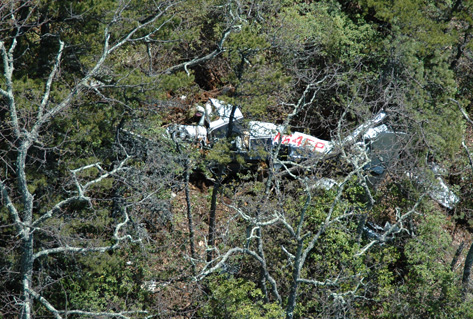
ASN Wikibase Occurrence # 17804
This information is added by users of ASN. Neither ASN nor the Flight Safety Foundation are responsible for the completeness or correctness of this information.
If you feel this information is incomplete or incorrect, you can submit corrected information.
| Date: | Monday 12 May 2008 |
| Time: | 05:33 |
| Type: |  Piper PA-32-260 |
| Owner/operator: | Private |
| Registration: | N64FP |
| MSN: | 32-535 |
| Year of manufacture: | 1966 |
| Total airframe hrs: | 2124 hours |
| Engine model: | Lycoming O-540-E4B5 |
| Fatalities: | Fatalities: 2 / Occupants: 2 |
| Aircraft damage: | Destroyed |
| Category: | Accident |
| Location: | on a ridge near Cruso, about 20 miles southwest of Asheville, NC -
 United States of America United States of America
|
| Phase: | En route |
| Nature: | Private |
| Departure airport: | Rutherfordton, NC (FQD) |
| N. Little Rock, AR (ORK) | |
| Investigating agency: | NTSB |
| Confidence Rating: |
The non-instrument-rated private pilot departed in the early morning hours, before daylight, on a cross-country flight. There was no record of the pilot receiving a preflight weather briefing from either a Flight Service Station or a computer service. About 30 minutes into the flight, the airplane changed its heading twice with accompanying rapid changes in altitude. Shortly thereafter the airplane began a rapid descent and collided with steep mountainous terrain. According to radar analysis of the flight conducted by a Safety Board meteorology specialist, the first-half of the flight took place under visual meteorological conditions; however, during the remainder of the flight the airplane most likely entered both a wave cloud and a layer of broken-overcast clouds that bordered the flight path. Strong northwesterly winds normal to mountain ridges existed in the general area at the time of the accident. These winds would have caused the airplane to experience moderate to severe turbulence, and strong downdrafts due to either mechanical turbulence or mountain waves in the location where the final rapid descent occurred. There was no evidence of premishap mechanical malfunction or failure observed during the examination of the engine or airframe.
Probable Cause: The pilot's inadequate preflight planning and inadvertent flight into instrument meteorological conditions with moderate to severe turbulence prevailing. Contributing to the accident were the instrument meteorological conditions and turbulence.
Accident investigation:
 |
|
Sources:
NTSB
Location
Images:

(c) NTSB
Revision history:
| Date/time | Contributor | Updates |
|---|---|---|
| 14-May-2008 12:20 | Fusko | Added |
| 22-May-2008 23:19 | Fusko | Updated |
| 31-May-2008 23:54 | harro | Updated |
| 21-Dec-2016 19:14 | ASN Update Bot | Updated [Time, Damage, Category, Investigating agency] |
| 21-Dec-2016 19:16 | ASN Update Bot | Updated [Time, Damage, Category, Investigating agency] |
| 21-Dec-2016 19:20 | ASN Update Bot | Updated [Time, Damage, Category, Investigating agency] |
| 03-Dec-2017 10:52 | ASN Update Bot | Updated [Operator, Other fatalities, Departure airport, Destination airport, Source, Narrative] |
Corrections or additions? ... Edit this accident description
The Aviation Safety Network is an exclusive service provided by:


 ©2024 Flight Safety Foundation
©2024 Flight Safety Foundation